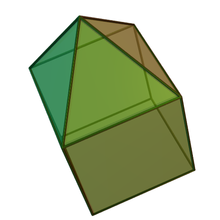|
Elongated square pyramid
In geometry, the elongated square pyramid is a convex polyhedron constructed from a cube by attaching an equilateral square pyramid onto one of its faces. It is an example of Johnson solid. ConstructionThe elongated square bipyramid is a composite, since it can constructed by attaching two equilateral square pyramids onto the faces of a cube that are opposite each other, a process known as elongation.[1][2] This construction involves the removal of those two squares and replacing them with those pyramids, resulting in eight equilateral triangles and four squares as their faces.[3] A convex polyhedron in which all of its faces are regular is a Johnson solid, and the elongated square bipyramid is one of them, denoted as , the fifteenth Johnson solid.[4] PropertiesGiven that is the edge length of an elongated square pyramid. The height of an elongated square pyramid can be calculated by adding the height of an equilateral square pyramid and a cube. The height of a cube is the same as the edge length of a cube's side, and the height of an equilateral square pyramid is . Therefore, the height of an elongated square bipyramid is:[5] Its surface area can be calculated by adding all the area of four equilateral triangles and four squares:[3] Its volume is obtained by slicing it into an equilateral square pyramid and a cube, and then adding them:[3]  The elongated square pyramid has the same three-dimensional symmetry group as the equilateral square pyramid, the cyclic group of order eight. Its dihedral angle can be obtained by adding the angle of an equilateral square pyramid and a cube:[6]
See alsoReferences
External linksInformation related to Elongated square pyramid |
||||||||||||||||||||||||
















